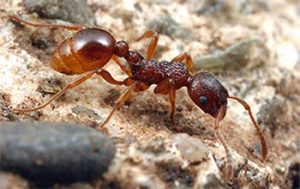They’re here.

Photo credit: Alex Wild, image from WorkSafeBC’s European fire ants in the workplace
European fire ants are a risk to anyone who works outside, especially where I live, in Metro Vancouver, BC, Canada.
Known to bug scientists as Myrmica rubra, these small (4-5 mm long), reddish-brown ants are native to Europe and Asia. They first appeared in BC’s Lower Mainland in 2010 and their population continues to grow.
“The European fire ant has a stinger that can inject venom under the skin,” reads this WorkSafeBC hazard alert: European fire ants in the workplace.
“After a sting, a burning sensation develops and can last from 30 minutes to 2 hours. The burning is followed by itchiness that can last up to a week. At a minimum, stings cause swelling, redness, and discomfort. In rare cases, they can result in a severe allergic reaction… These ants are very aggressive.”
CBC news reports Fire Ants force CP to incinerate Arbutus rail ties; that’s on an unused line that runs from the Fraser River to Burrard Inlet on the city’s west side.
“On a warm day it’s going to look like an ant volcano exploded out of the ground. That’s how aggressive they are,” says Jennifer Grenz, project manager of the Invasive Species Council of Metro Vancouver, quoted in the CBC story above that also reports “runway delays at the Vancouver International Airport where birds swarming to eat the ants are crashing into planes.”
Where do fire ants live?
“Their nests are found in moist, shaded places such as lawns and grassy areas, under decaying logs, and in yard waste and potted plants,” reads the WorkSafeBC hazard alert. “Because these ants do not create a visible mound, it may not be obvious that an area is infested.”
One home gardener describes her experience being stung last summer.
“I was weeding around rocks and watering plants when I pushed over a stone and a flurry of ants was running in all directions,” she says.
“I stood there briefly, then one suddenly bit me – up my pant leg, on my shin – and my god, it was painful for such a small thing! I brushed it off and jumped around with ants up my pants! Luckily I didn’t get nailed by any more. Needless to say, for the rest of the summer while watering I would stand well away with my watering wand.”
How to prevent being stung by fire ants
Wearing clothing and footwear that covers exposed skin can help. WorkSafeBC suggests you “wear long-sleeved shirts, long pants, socks, closed-toe shoes (or rubber boots), and gloves. Pants can be tied or taped to socks or boots.”
So we have to look out in the garden this summer. Yikes! (Makes my skin crawl… ew!)


